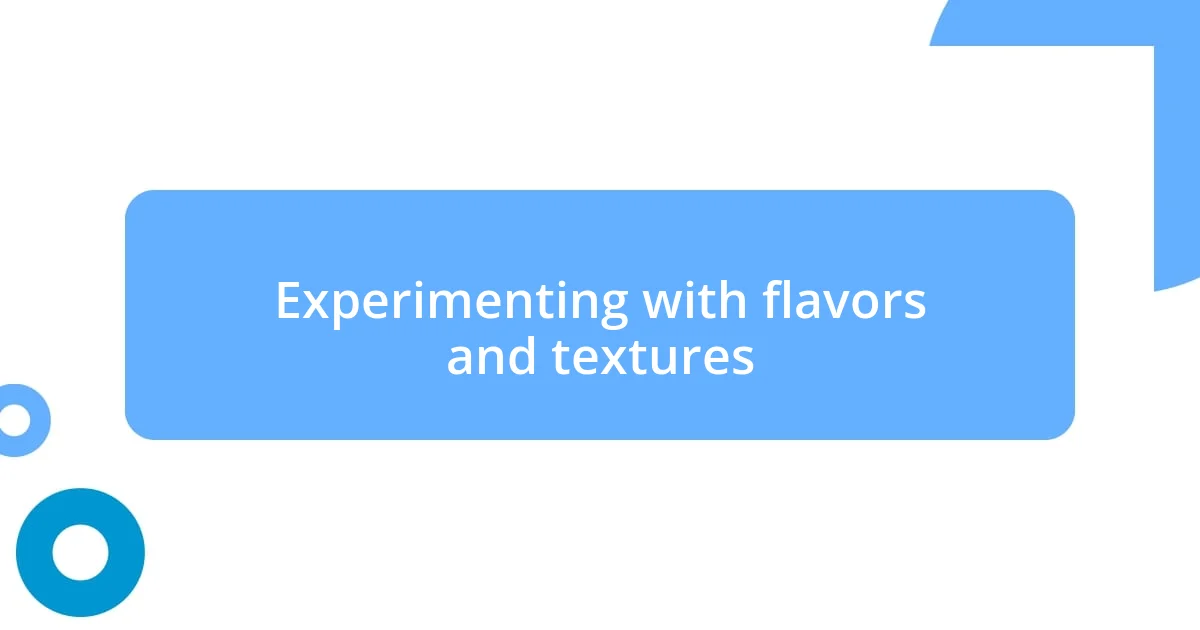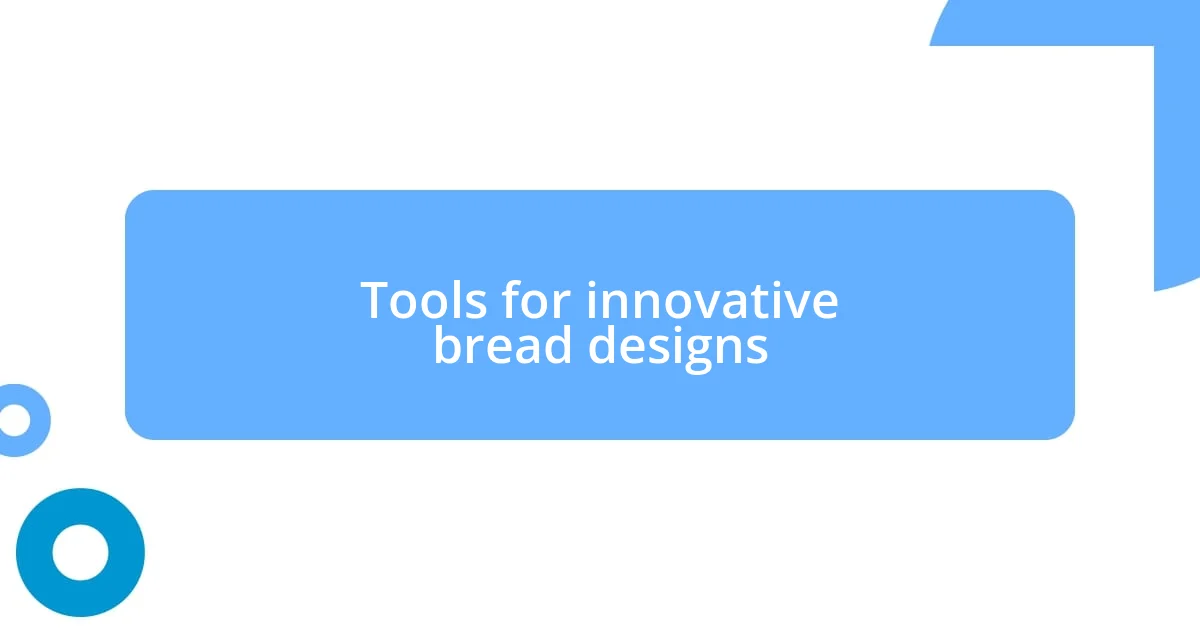Key takeaways:
- Nature inspires creativity in bread design, influencing textures and colors derived from natural elements.
- Cultural traditions shape bread-making, with unique shapes and flavors telling stories and connecting generations.
- Experimentation with flavors, textures, and tools significantly enhances the bread-making process, allowing for innovative and artistic expressions.

Sources of bread design inspiration
When I dive into my bread designs, I often find inspiration in nature. For instance, the vibrant colors of autumn leaves or the delicate patterns found in a flower’s petals can spark ideas for textures and shapes I bring to my loaves. Have you ever paused to admire how nature’s beauty is so effortlessly woven together? This connection reminds me that bread, much like nature, is an art form that thrives on organic creativity.
Cultural traditions also play a significant role in my design process. I cherish the memories of baking with my grandmother, who would tell stories about each recipe’s origin. Those moments are infused with love and history. Isn’t it fascinating how food transcends generations? Each loaf I create that reflects those rich traditions feels like honoring not just my heritage but also the stories intertwined in the grains of flour.
Lastly, I look to the culinary world around me. From food markets brimming with fresh produce to the latest baking trends on social media, there’s always something to ignite my imagination. I remember walking through a bustling market, seeing ingredients laid out like a painter’s palette, and thinking about how I could incorporate those colors and flavors into my next creation. What inspires you the most when you think about the ingredients you work with? It’s this blend of influences that keeps my bread designs fresh and exciting.

Nature as a design muse
When I step outside and immerse myself in the natural world, I often feel a surge of creativity flowing through me. I distinctly remember one afternoon in the spring when I wandered through a blooming garden, captivated by the play of light on the petals of tulips. Those asymmetric shapes and vibrant hues inspired me to experiment with color gradients in my sourdough crusts. Each loaf became a canvas, reflecting the essence of what I witnessed in that moment of tranquil beauty.
- The intricate patterns of tree bark can lead to unique crust designs.
- The rich colors of fruit in the wild inspire flavorful additions to my dough.
- Observing the movement of leaves in the wind inspires fluid shapes in my bread.
- The textures of stones alongside the river remind me to play with crunchy toppings.
Nature, in its ethereal forms, reminds me that my bread should not only align with taste but also capture the essence of the world around me. There’s something almost spiritual about translating those natural inspirations into my craft – it bridges the gap between nourishment and artistry.

Cultural influences on bread shapes
Cultural influences deeply shape the way I approach bread designs. For instance, looking at the traditional round loaves from various cultures, I feel a connection to the communal aspect of bread-making. Growing up in a multicultural neighborhood, I remember seeing how each family’s unique bread shape told a different story; from the elongated baguettes of France to the elaborate braided challah from Jewish traditions. These shapes aren’t just aesthetic; they carry the weight of centuries of practice and love. Doesn’t it make you wonder about the significance behind your favorite loaf?
As I venture into different cuisines, I get inspired by their distinct bread shapes and the symbolism attached to them. The fan-shaped fanesca bread, for example, is not only visually striking but also represents the blend of indigenous and colonial influences in Ecuador. I vividly recall the first time I tasted it during a festival—it was like experiencing a piece of culture through flavor and shape. Each bite and fold of that bread evoked a sense of belonging and connection, underscoring that there’s so much more than taste in our culinary traditions.
Additionally, regional ingredients often dictate the diversity of bread shapes. Take Italy, for example, where the use of local grains can lead to delightful variations like focaccia and ciabatta. I once had the chance to bake alongside an Italian baker, who showed me how to manipulate dough into a rustic, freeform shape—all inspired by the vast landscapes surrounding their home. It’s in these moments that I truly appreciate how culture and geography dance together, influencing not just what we eat, but how we express our creativity through bread-making.
| Culture | Traditional Bread Shape |
|---|---|
| France | Baguette |
| Jewish | Challah |
| Ecuador | Fanesca |
| Italy | Ciabatta |

Experimenting with flavors and textures
Experimenting with flavors and textures is perhaps one of the most fulfilling aspects of my bread-making journey. One evening, I decided to infuse my sourdough with rosemary and garlic. The aroma filled my kitchen, creating an atmosphere that felt both rustic and inviting. It made me wonder: how can a simple loaf evoke such warmth and comfort? I believe it’s in the intricate dance of flavors and textures that bread transforms into something truly special.
Playing with textures has prompted me to venture beyond conventional toppings. I recall the first time I added seeds and nuts to my crust—I was amazed by the delightful crunch against the soft interior. It felt like discovering hidden treasures in every bite. I often ask myself, “How can I elevate this experience further?” The inclusion of toasted sunflower seeds not only added a wonderful nutty flavor but also a delightful contrast that I find irresistibly satisfying.
What truly excites me is the unexpected pairings I explore. I once paired a sweet fig compote with a sharp cheddar bread, and the resulting flavor profile was nothing short of magical. This combination sparked a realization: experimenting is where the art of bread-making lies. It’s about letting go of preconceived notions and welcoming the thrill of possibility. Have you ever had a flavor surprise you? It’s those moments that remind me of the joy embedded in every loaf I create.

Tools for innovative bread designs
In my journey of creating innovative bread designs, the right tools have made all the difference. I often rely on a high-quality bench scraper for shaping my dough. There’s something deeply satisfying about how it glides through the surface, allowing me to create clean lines and interesting shapes. Have you ever used a tool that transformed your approach to a craft? For me, that moment came when I discovered how a simple tool could elevate my bread-making technique.
Moreover, specialty baking pans, like those designed for Pullman loaves, have opened up new avenues for experimentation. When I first tried a Pullman pan, I was amazed at how the square shape influenced my presentation while also creating beautifully even slices. It’s like stepping into a whole new world each time I pull out my beloved pan; I can’t help but wonder what unique flavors I could experiment with in this new form. Each bake feels like a blank canvas, just waiting for my next creative expression.
Don’t overlook the impact of tools such as embossing mats or stencils either. I remember the thrill of using a stencil to dust flour onto a loaf, transforming a simple bread crust into an eye-catching design. The first time I revealed the patterned surface, I felt a rush of pride and excitement—it turned my sourdough into a focal point at the dinner table. Isn’t it incredible how the right tools not only enhance functionality but can also spark creativity? Over the years, I’ve learned that each tool has the potential to tell a story through my bread, inviting others to connect with my creations on a deeper level.














